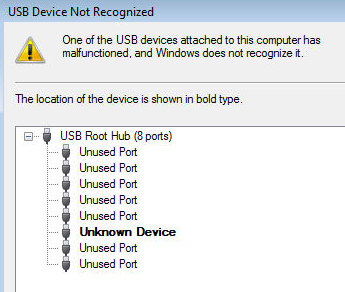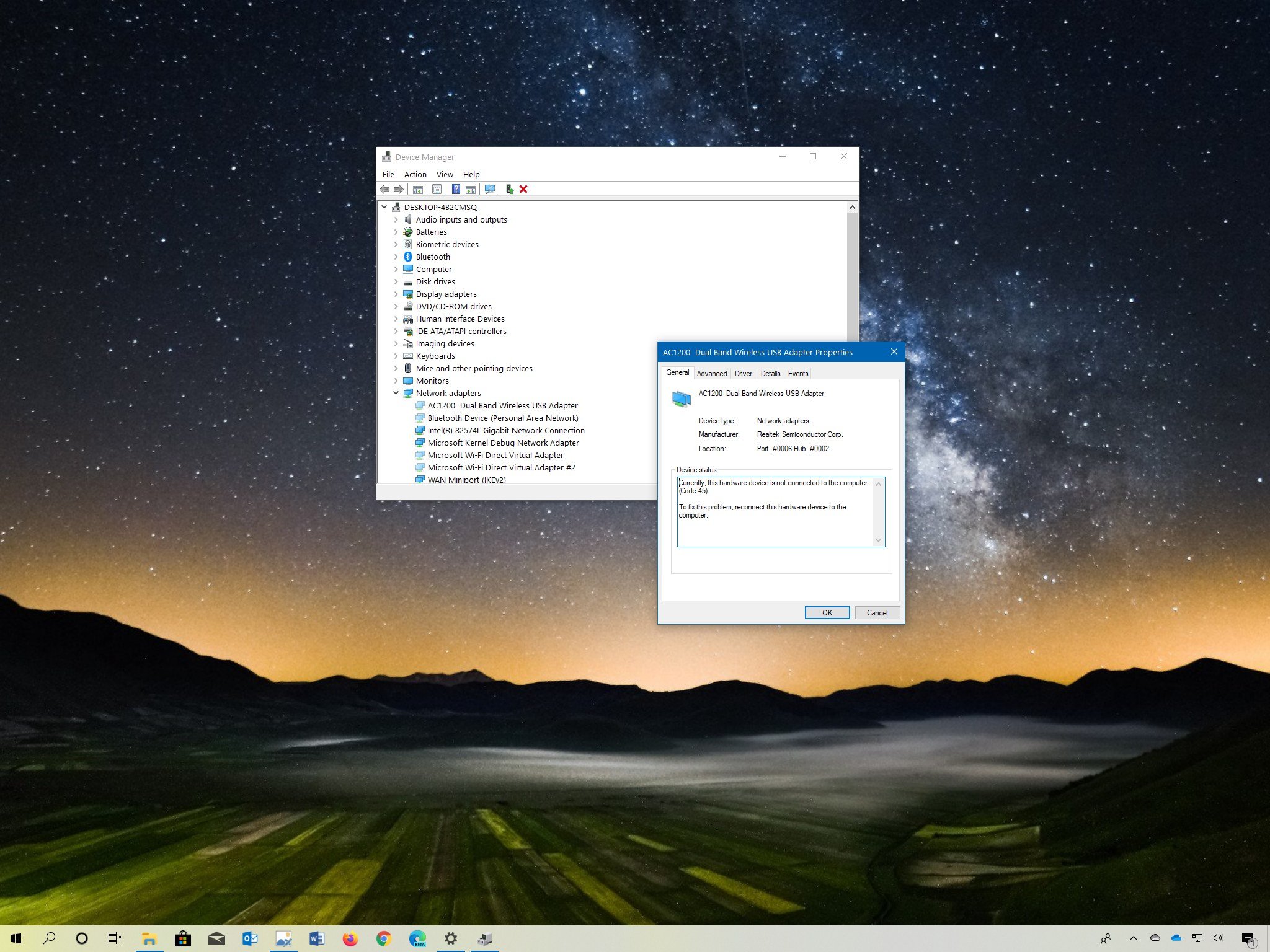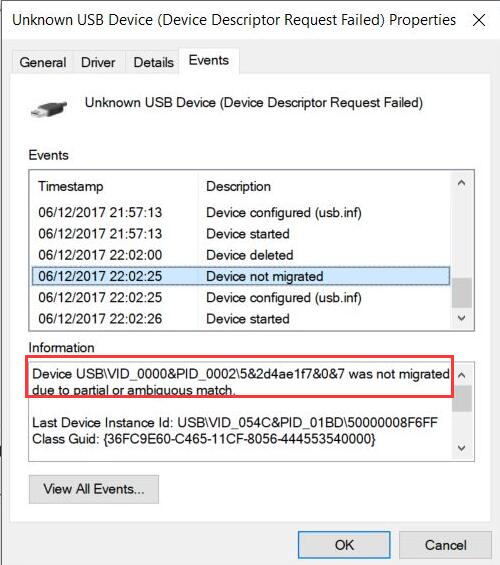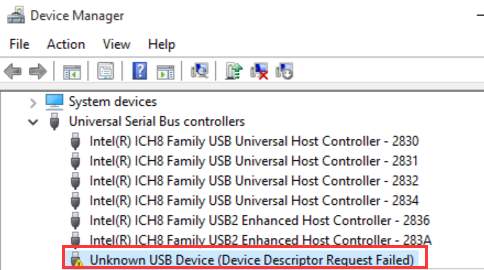- Windows 10 Driver Error Fix
- Unknown Usb Device (device Descriptor Request Failed) Driver Error Windows 10
- Drivers Not Installed Code 28
If you find the unknown USB device error even after running the troubleshooter, you can try using this solution to solve your error. Open device manager on your device. Open a Run window by pressing Win + R, type devmgmt.msc and press Enter to launch the window.
In this video, we're going to show you how to fix Unknown USB Device (Device Descriptor Request Failed) Error. We can solve the problem by reinstalling the U. If the device-specific driver is distributed through Windows Update, you can manually update the driver by using Device Manager. For more information about how to do this, see update drivers in Windows 10. If the device is not yet connected, first install the device-specific driver, such as by using the appropriate installer. Go to Knowledge Base 974476 The computer stops responding when the USB device continues to run from the Selective USB Difference status in Windows 10 or Windows Server 2008 R2. Select View and request revision downloads Select revisions. If requested, consult the license agreement. If you agree to the terms, choose I accept. USB devices are one of the commonly used devices every day – from plugging mobile devices for charging using pen drives, you are making use of USB drives. However, there are times when you might encounter an error message saying, “Unknown USB Device” as you plug your USB device on your Windows 10 computer.
-->This article helps to fix an issue in which Windows 10 doesn't install specific drivers for USB audio devices on the first connection.
Original product version: Windows 10, version 1703
Original KB number: 4021854
Symptom
When you connect a USB audio device to a Windows 10 Version 1703-based computer the first time, the operating system detects the device but loads the standard USB audio 2.0 driver (usbaudio2.sys) instead of the specific device driver.
Cause
This issue occurs because the USB audio 2.0 driver (usbaudio2.sys) isn't classified as a generic driver in Windows 10 Version 1703. Therefore, the system assumes that a compatible, nongeneric driver is installed for the device even though the driver is generic.
This issue also causes Windows 10 Version 1703 to postpone the search for other compatible drivers through Windows Update that typically occurs immediately after you install a new device.
Resolution
To fix this issue, use one of the following methods.
Method 1
To resolve this issue, install update 4022716.
Method 2
If the device-specific driver is distributed through Windows Update, you can manually update the driver by using Device Manager. For more information about how to do this, see update drivers in Windows 10.
Method 3
If the device is not yet connected, first install the device-specific driver, such as by using the appropriate installer. After the device-specific driver is installed, Windows 10 will select that driver instead of the standard USB audio 2.0 driver when you first connect the device.
Note
See the device manufacturer's user guide for specific instructions about how to install the driver.

Method 4

Windows 10 Driver Error Fix
If the driver isn't distributed through Windows Update, you can manually reinstall the driver. To do this, follow these steps:
- Install the device-specific driver (see Method 2).
- Open Device Manager.
- Right-click (or tap and hold) the name of the device, and then select Uninstall.
- Restart the computer.
When it restarts, Windows will try to reinstall the device by using the device-specific driver.
Dec 16, 2020 • Filed to: USB Recovery • Proven solutions
Many users have experienced such a downfall in the quest to fully utilize their computers. It happens that sometimes, you plug a USB device but instead of functioning well, you are greeted with device request descriptor failed - pop up message. So devastating! Worry no more because that is exactly what this post is going to help you overcome.
Part 1. Overview of the Error
USB devices are important storage hubs that are used from time to time. Apart from storage, they are also a good forum for transporting files from one device to another. Talk of being small in size, easy to handle, and larger in storage capacity with numerous categories such as memory card, USB flash drive, pen drive, among others. So, you can imagine the magnitude of frustration when you encounter the device request descriptor failed at the eleventh hour into accessing a much-awaited for the file.
The USB device descriptor is the part that stores information for any of your USB gadgets. And when it fails, it means it is not able to recognize a USB device. The result is error messages such as 'one of the USB devices attached to your computer has malfunctioned, unknown USB device or tries reconnecting the device' among other baring messages.
So, what's the warning sign?
As soon as you open the 'Device Manager', you should see the USB device that's displayed under Universal Bus Controllers marked with an exclamation mark, yellow in color. Additional 'device request descriptor failed' message may also be displayed. This should be the starting point of you identifying the real problem. Check the portrayed message properties to identify the error at a point. And a plethora of causes throws you to such disarray. Check them out on our next topic!
Part 2. What Causes the 'Unknown USB Device' Error?
Several causes lead to this problem. Identifying the exact cause is the first step into helping you determine the right method to solve the issue on your Windows or other devices. Let's see how to pinpoint the root cause of unknown USB device error.
- A connection issue will result in a USB device that doesn't communicate properly with the computer. This usually reports the 'error code 43'
- Windows may also fail to find the description of your USV device
- The computer may also turn off various devices when there is a power shortage. The remedy is to disable this option in the 'Device Manager'
- If the USB device is using outdated or corrupted drivers
- If the USB drive contains bad sectors, it automatically gets damaged and will hinder further connectivity of the USB device with the computer
- Windows OS may also be missing important updates and just refuse to recognize the USB
Part 3. How Do I Fix an Unknown USB Device?
Quick Fix:

1. Try the USB device with a different USB port
In some cases, it could be that the device request descriptor failed because the USB port is malfunctioning. In such a case, you need to check each of the available USB ports individually. By this, you will be able to determine whether the problem is due to the port or not.
Unknown Usb Device (device Descriptor Request Failed) Driver Error Windows 10

Plug your USB device in one port at a time. Repeat the procedure until you have tried all the USB ports. It will be easy to pinpoint which particular port has a mishap.
2. Connect the USB device to another PC
Your PC may also be the root cause of the USB descriptor failed. Possible causes may be a bad sector in the Windows OS, outdated drivers on your computer, or non-functional USB ports. Trying out another PC may help arrest the situation.
Unplug your USB device from the computer in question and connect it to another PC. If it is recognizable, then you know that the problem lies with the earlier used computer and not the USB drive.
Advanced Fix:
The first two quick fixes may not have yielded any fruit and you could be compelled to look into other solutions with in-depth performance.
1. Uninstall the USB Driver in Device Manager
This is when your computer needs a revamp probably from corrupted or outdated files. Follow these steps to uninstall the USB drive from the Device Manager.

- Open the Device Manager. Then open the 'Run dialog' box by pressing the 'Windows' and 'R' keys together. Type in 'devmgmt.msc' in the Run and then click the 'OK' button. This will open the Device Manager.
- Next, expand the category Universal Serial Bus Controllers. From the options, you can locate the USB drive that is not being recognized. It should be tagged with a yellow sign of 'Unknown USB Device' error.
- Right-click on that USB drive and choose the 'Uninstall' option. Then, restart your computer as soon as the drivers have been uninstalled successfully.
- Some Windows OS will reinstall the drivers automatically. Otherwise, you can also reinstall the drivers manually.
2. Update the USB Driver
- Go to the 'Start' menu then click on the 'Device Manager' to open the Device Manager platform.
- Next, browse and expand option 'Universal Serial Bus Controllers'
- Then right-click on the 'Generic USB Hub' entry option and select the 'Update Driver Software'
- The 'Update Driver Software Generic USB Hub' window will pop up. Check out for the driver software available for your computer. You'll be able to locate and install driver software manually.
3. Disable Fast Startup
This is another way to fix device descriptor request failed that will also prevent your USB device from powering down.
- Click the 'Start' button and then type in 'power plan'. Next, select the 'Choose a power plan' option from the results listed.
- Then click on the 'Change Plan Settings' option. Further, select the 'Change Advanced Power Settings' option.
- Expand the 'USB Settings' by clicking the box with a 'plus' sign. Once expanded, select the 'USB selective suspend settings' and pick on the 'Plugged in' option.
- Go to the drop-down menu and select the 'Disabled' option. Next, tap 'Apply' and then click on the 'OK' option. This will disable Fast Startup and help in the unknown USB device fix.
4. Update Generic USB Hub
- To update the Generic USB Hub, go to the 'Start' menu, and select the 'Device Manager' option.
- Once the Device Manager opens, browse the available list and expand option 'Universal Serial Bus Controllers'
- Once more, right-click the 'Generic USB Hub' entry and pick on the 'Update Driver Software' option
- The Update Driver Software Generic USB Hub will pop up. Select the 'Browse my computer for driver software' option. By this, you can now locate and install the driver software manually on your computer.
- Select 'Let me pick from a list of device drivers on my computer' list option. All the driver software that is compatible with your device will be shown on the list.
- Pick the 'Generic USB Hub' item that suits your match and then click the 'Next' button. The installation will begin in due course. Wait for its completion.
Conclusion
In a nutshell, it is possible to outrightly perform a USB unknown device fix for your windows 7 or any other higher version. The above quick-fix options are simple and do not need any high-tech know-how. However, there are further advanced fixes that will dig deeper into your system and solve the unknown USB device almost instantly.
Recoverit - The Best USB Data Recovery Software
- Recovers and reads files in 1000+ file formats and restore them with 95% efficiency;
- Supports each external storage source including a USB flash drive, external hard disk, an SD card, camera, camcorder, drone, and many others;
- Available for both if your macOS & Windows devices;
- Recovers data from situations like virus-infected and crashed computer, and formatted deletion;
USB Solution
Drivers Not Installed Code 28
- Recover USB Drive
- Format USB Drive
- Fix/Repair USB Drive
- Know USB Drive